A time to kill?
Austin's no-kill ordinance has become a third rail.
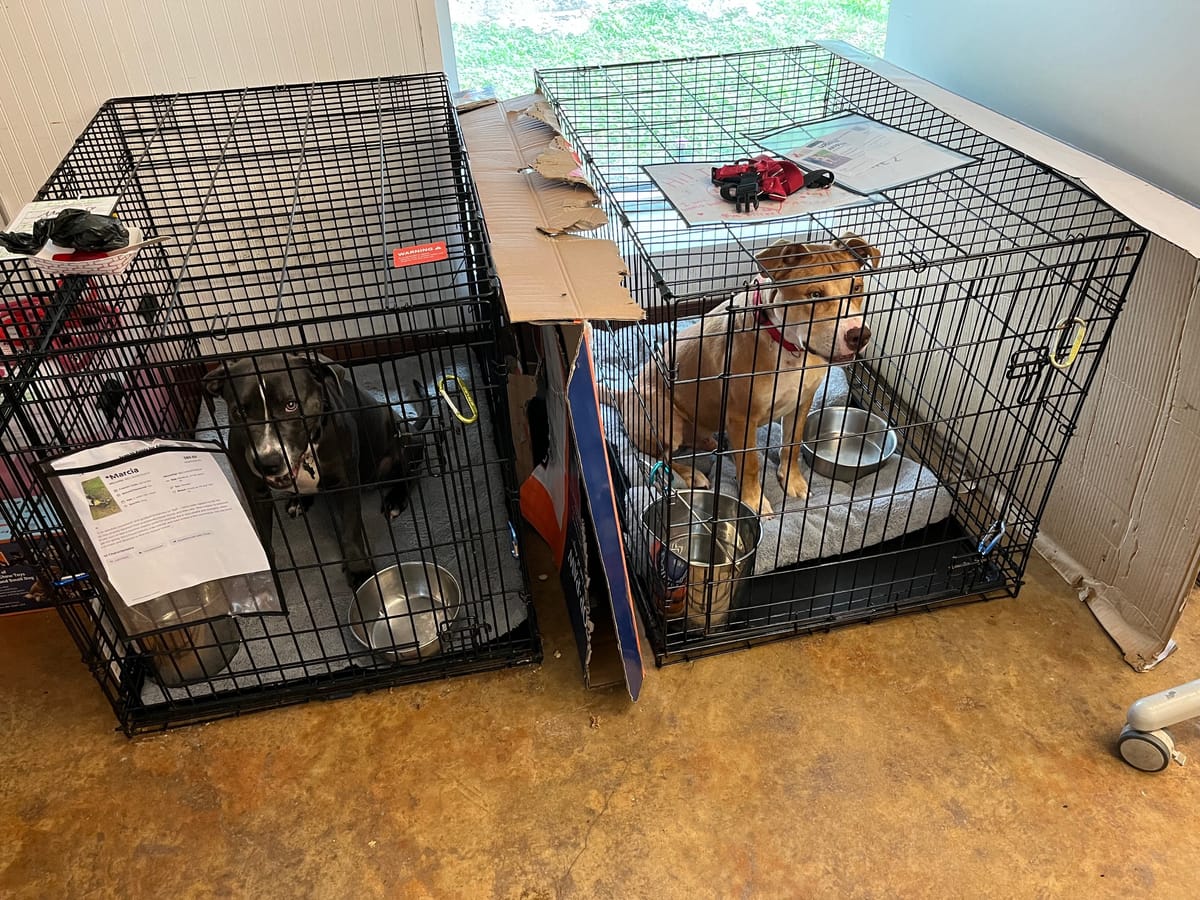
Of the many characters I've seen exercise their right to address City Council, perhaps the boldest was Robert "Crocodile" Corbin, who in years past would periodically show up to plead for the city to start killing dogs.
Corbin's arguments for ending the city shelter's "no kill" policy was infused with an unmistakable contempt for canines, with whom he claimed to have had numerous violent confrontations in city parks. Why, he asked at a meeting in 2016, in a city with so many humans in need, are we spending millions to rescue these noxious creatures whose poop pollutes our creeks and whose fangs menace our children?
"Please kill 'no kill,'" he concluded.
These days, a surprising number of dog-lovers in Austin don't entirely disagree with Corbin. Few are willing to self-describe as opponents of no-kill, but they argue that the city's rigid adherence to a goal of maintaining a "95% live release rate" has harmed animals and put the public at risk.
Today, City Council is poised to take one small step back from the no-kill dogma. It will consider rule changes to allow the shelter greater discretion in deciding whether a dog should be euthanized on public safety grounds.
The current rules do not bar the shelter from euthanizing animals for any reason. However, unless the animal has "a documented history of unprovoked biting that has resulted in severe injury to a person," the shelter must first provide an opportunity to rescue groups to take the animal. In a number of instances, dogs that staff deem too dangerous for human interaction have been released to rescue groups that have a much higher tolerance for dog bites.
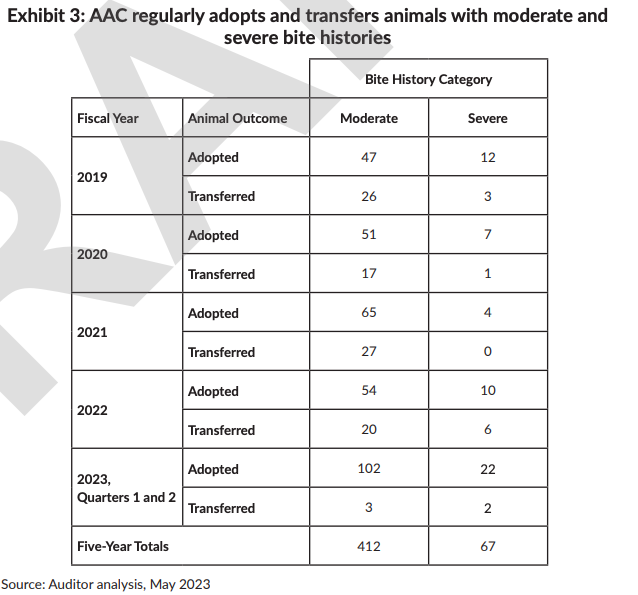
In one hilarious-if-not-horrifying incident a year ago, AAC allowed rescue group Final Frontier to take a dog that went on to not only severely injure the woman who agreed to foster it but three other strangers it interacted with after it ran away.
In the past few years, documented severe bites in Travis County have doubled.
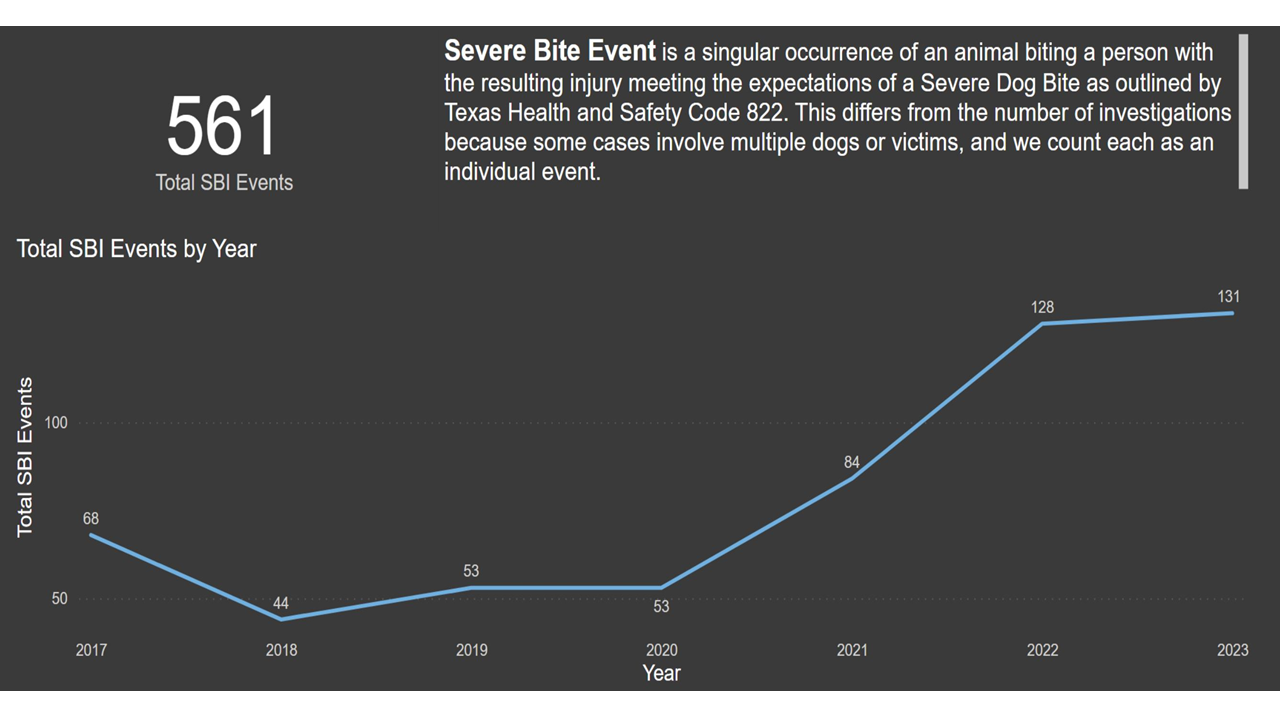
Whether the fault lies with the actual rules or with AAC leadership's unwillingness to enforce them, approving the rule changes today will send a signal to the shelter that City Council has its back, something that staff there say has been sorely lacking in recent years.
However, allowing the shelter to put down dangerous dogs, while a victory for public safety, is unlikely to meaningfully improve conditions for the hundreds of animals languishing at the Austin Animal Center.
Welfare vs. symbolism
The awful conditions at the city shelter are well-documented. The kennels are at capacity, prompting the shelter to store dogs in crates that now line the hallways of the facility and have taken over what used to be a conference room.
The extended confinement takes a toll.
"It's stressful for them, so they start declining mentally," Don Bland, the head of the city animal services division, told me in an interview at AAC last month.
A report commissioned by the City Auditor and conducted by evaluators from the National Center for Animal Shelter Evaluations was scathing, describing the shelter as a filthy health hazard to humans and animals alike. Among many other things, the evaluators documented hair-clogged vents that hadn't been cleaned in years, kennel walkways that are "nothing more than an above ground cesspool" beckoning disease, and crates that were too small for some dogs to stand up. They also described instances of staff and volunteers who were clearly unqualified to deal with large, aggressive animals.
The NCASE audit pinned much of the blame on the shelter's current leadership, which is "not being held accountable for the conditions of the facility, which has taken many months, if not years, to devolve to this state."
However, the report also pointed a finger at the no-kill policy itself. The report does not explicitly recommend that the city revise its policy, but it made it clear, with (rhetorical) questions like these, that it's something to consider:
Is the 95% live release rate a sustainable rate based on data or is it symbolic in nature to achieve?
Is the City interested in providing humane care that meets that needs of the animals and community they serve, or is the City more interested in maintaining the 95% live release rate for the prestige and accolades it receives?
What is the trade-off, if any, the City of Austin is willing to accept with these two factors?
Furthermore, the report notes that the criteria for "no-kill" have never been clearly established by any expert body. The 90% live-release rate –– the goal the city originally set in 2010 –– is simply a number that "stuck to the wall" and is now frequently cited as the standard.
Reacting to the audit in September, Council Member Leslie Pool said it was clear that the city shelter needed new leadership.
"I have lost confidence in the Animal Services Officer," she said, referring to Don Bland, who has been in the role since August 2019.
Tawny Hammond, who ran the shelter from 2015-17, also called for Bland's head in a guest column for the Austin Chronicle.
Many other animal welfare advocates, however, roll their eyes and say that Bland is a scapegoat for bad policy set by elected officials. Worse, they argue, the people persecuting him are the ones who actually stand in the way of progress.
The elephant in the room
In conversations with employees of the animal shelter and many longtime advocates of animal welfare, they repeatedly point the finger at Austin Pets Alive! and its influential leader, Ellen Jefferson.
APA! is the local nonprofit that led the campaign to make Austin one of the nation's first major no-kill cities. APA!'s activists not only urged the city to adopt a no-kill policy at the shelter, but pledged to help the city by taking in a large share of the shelter's animals.
To the casual observer, APA! is merely in the business of saving and adopting animals. Indeed, because APA! now occupies (rent-free) the site formerly occupied by the city shelter on Cesar Chavez, it's common for people to confuse it with the city facility, which has since relocated to a site on the east side.
Many others involved in animal welfare, however, describe APA! as a cult-like organization that relentlessly undermines the city shelter –– and animal welfare –– on behalf of a discredited ideology and its own business interests.
So central is APA! to animal welfare in this community that the key distinction among activists in the arena is whether they are an APA! friend or foe. Until recently, those aligned with the nonprofit –– employees, board members, volunteers –– had a majority on the Animal Advisory Commission, the volunteer board appointed by City Council to advise on animal welfare policy.
When Paige Nilson, a veterinarian and contractor for the shelter, was appointed to the commission by Council Member Chito Vela in the spring of 2022, she recalls a solid 8-person majority that "would always vote in lockstep" with APA!
The most notable instance came shortly into Nilson's tenure, when she proposed altering the no-kill ordinance to allow the shelter to spay "visibly pregnant" animals. In other words, animal abortions.
The APA!-linked commissioners denounced the proposal in rhetoric that in any other context would be associated with the religious right.
Commissioner Ryan Clinton, an attorney and longtime APA! disciple who takes credit for authoring the no-kill ordinance, noted that APA! agrees to take newborn puppies and kittens born at the shelter.
"I'm so proud that we have a rescue group that is willing to save not only those in utero animals but the pregnant moms as well," he said.
"It’s not a humane tool when the animal is that pregnant to take away all of their babies," Jefferson told me in an interview several months ago.
Nilson derided "visibly pregnant" as a "completely subjective, arbitrary measure with zero biological underpinning."
The commission makeup has changed with the election of new Council members, three of whom appointed members unaffiliated with APA! However, efforts by Council members to revise the abortion policy, including in the ordinance Council is considering today, have been repeatedly stopped due to fierce opposition by APA!
Although APA! happily takes puppies and kittens, which are much easier to adopt, it has successfully lobbied Council to significantly reduce the number of total shelter animals it is required to care for.
In 2012, the agreement between the shelter and APA! required the nonprofit to take in the greater of either 3,000 animals or 12% of the shelter's prior year intake. APA! was allowed to shelter animals from other sources from within the five county Austin metro area.
Four years later, Council amended the agreement to allow APA! to take in animals from outside the metro area for up to 21 days. Finally, in 2022, following a resolution by Council that was the result of heavy lobbying by APA!, the city agreement was amended to drop the "greater of" language and to lift any geographic restrictions on APA!'s intake.
"Under the amended agreement, for 2022 and 2023, APA is expected to take less than half of the number of animals it would have under the previous agreement," stated the report published by the city auditor.
As a result of the changes to the agreement, APA! continues to operate on city land while shouldering a much smaller share of the area's stray animal problem. Furthermore, it is now allowed to bring in an unlimited number of animals from outside of the area to adopt, thereby increasing competition with the shelter.
It's a competition that the city facility is doomed to lose, say shelter advocates, because APA! is able to pull at dog-lovers' heartstrings in a way that the shelter cannot. Those on APA!'s mailing list are bombarded with appeals to save canines at risk of euthanasia from "kill shelters" around the state. For instance:
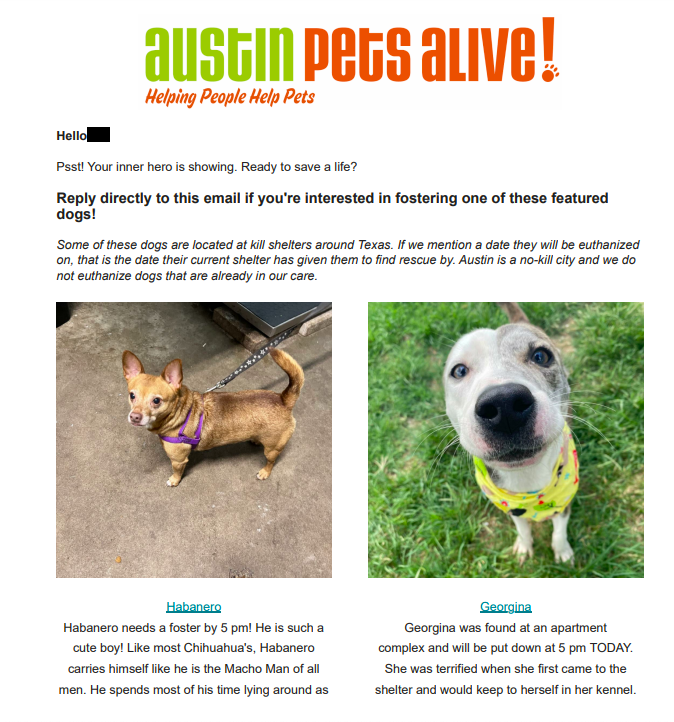
If you want to save a dog's life, why would you bother adopting one from the city shelter if you've been assured it is "no kill"?
"I find it frustrating that City Council has consistently backed the interests of APA! over our own animal shelter," Jo Anne Norton, a longtime animal welfare advocate, told me recently.
Norton was once an APA! volunteer herself, and she was profiled a few years ago in the Austin Chronicle as a vocal supporter of no-kill. Her views on the nonprofit have since soured and she now volunteers at the shelter. She says she still believes in no-kill, but that she supports balancing it with "quality of life" for animals and "public safety."
Norton's views are common among those who are deeply engaged in animal politics, but she was one of the few willing to speak on the record. Others say that they worry that speaking out against APA! will jeopardize their ability to engage in advocacy or volunteering.
Jefferson frames her organization's reduced intake from the shelter as the logical evolution of a relationship. APA! offered the shelter a hand up to achieve no-kill status, but it shouldn't be obligated to be a "dumping ground" for an incompetent shelter.
"If they have no interest in a foster program, no interest in a behavioral program, no interest in adoption, we can’t make up for that," she said.
In a November interview, Council Member Leslie Pool, who sponsored the most recent amendment to the agreement backed by APA!, said that the changes were negotiated by city staff and that "none of Council were party to those negotiations."
However, emails obtained in a public information request that were shared with me actually show Jefferson reaching out to Pool's office to thank her and her staff for pushing for changes that city staff was unwilling to support.
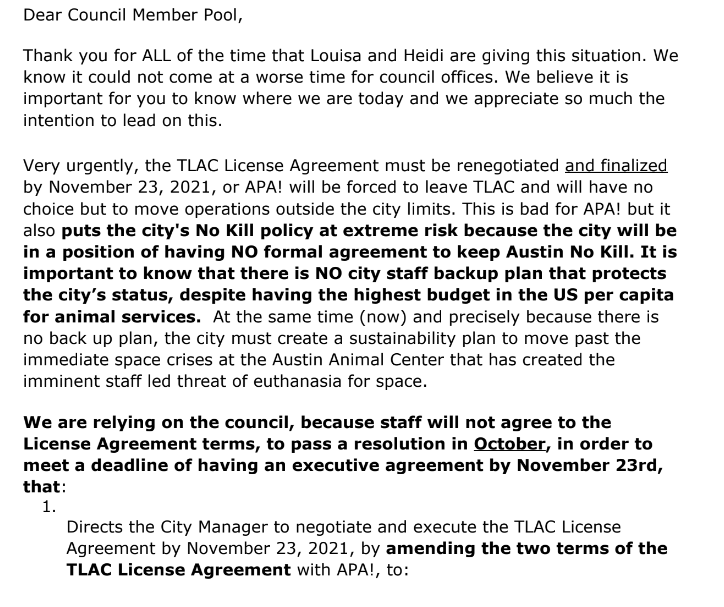
Pool pushed back on the notion that APA! had a sweetheart deal with the city, citing the flooding problems at the Cesar Chavez property. She defended lifting the geographic restrictions on APA!'s intake, saying that the nonprofit has "its own separate mission –– one of that is to be financially successful."
In 2022, the most recent year for which public records are available, APA! had gross receipts of $21.5 million, or about $3.5 million more than the operating budget of the city's animal services department in the 2022-23 fiscal year. (In the most recent budget, the department's allocation increased to $21 million)
What overpopulation?
"I feel that the fundamental divide is between those of us who see suffering as the enemy and those of us who see death as the enemy," says Nilson. "Those of us on the very frontlines of suffering and death, when you’re face to face with it, you fall on the side of suffering being your enemy."
Jefferson does not accept that there must be a choice between the two. That is in part because, in contrast to most other animal welfare organizations, she does not believe there is an overpopulation of animals.
Critics accuse APA! of aligning with breeders in opposing efforts aimed at reducing the animal population, such as past proposals to require strays that arrive at the shelter to be spayed or neutered.
"Animal welfare embraces an archaic and false narrative that 'there are not enough homes,'” Jefferson tells me by email. "That simple statement, if embraced, creates a scarcity mindset. There is no evidence that shows that, but plenty of evidence to support that there are more homes than there are shelter animals BY FAR."
Thus, to Jefferson, the city's problem isn't too many animals, it's that it's just not doing enough to connect its orphan dogs and cats with loving new families. The city should be more aggressively seeking fosters or working to reconnect stray animals with their owners.
"Just because the owner isn’t showing up to the shelter doesn’t mean they don’t want them," she told me in an earlier conversation last summer. "In an ideal world the [city] staff works with volunteers to paper the neighborhood where the dog was found or better yet, knock on doors."
Ultimately, Jefferson envisions a world where the municipal shelter plays a very narrow role, only taking in animals that are a serious public safety threat or in need of medical care. Limiting the shelter's role will "turn the entire community into the 'shelter,'" according to an email she sent to a group of animal welfare colleagues, including shelter staff, in April 2020. At the time, she described the pandemic as a historic opportunity to dismantle the traditional model of handling stray animals.
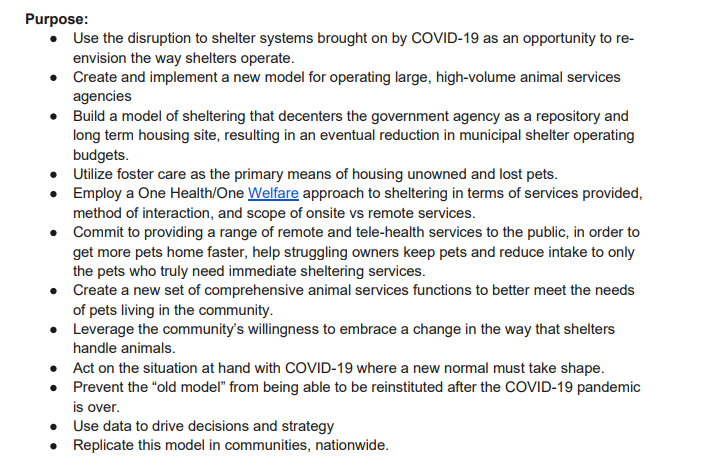
This was a concept that Jefferson has promoted through American Pets Alive!, the national advocacy group she launched to promote her unique brand of no-kill in cities around the country.
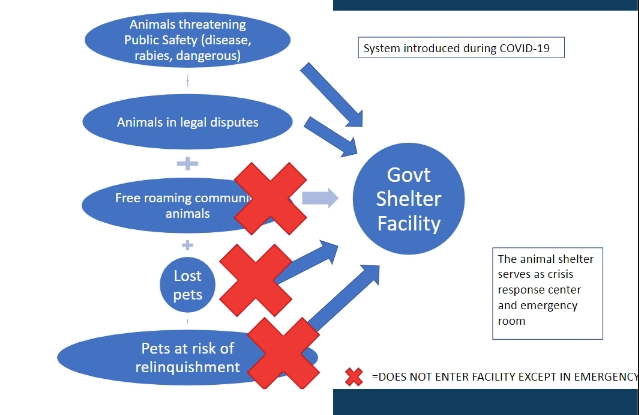
Critics of Jefferson allege that she is gradually pushing the city towards a situation in which stray "community dogs" are tolerated much like "community cats" already are. However, when I ask if she supports the concept, she responds, "I do not see it as a necessary or palatable option in Austin for dogs."
In some ways, the Austin Animal Center now aligns with Jefferson's vision: it is largely closed intake of healthy strays.
Two weeks after Jefferson sent the email in April 2020 outlining her vision, Bland largely endorsed it in an email to city management, saying the shelter should only take in "those animals that truly need a shelter" due to injury, illness or dangerous behavior. He acknowledged that the decision would be controversial, but said data showed that strays were more likely to reunite with their owners if left alone.
In an email yesterday, Bland reiterated that position and noted that one of the changes included in today's proposed ordinance will allow the shelter to set up a "finder-to-foster" program. The city law department has interpreted the current rules as requiring the shelter to hold any stray dog that is turned in for at least four days –– the new ordinance will allow the shelter to connect the dog with a foster immediately.
According to those involved in the crafting of the ordinance that is in front of Council today, it was significantly altered to accommodate concerns from Jefferson.
And yet, it does not appear that APA! advocates are satisfied. In a post on his website, Clinton, the author of no-kill, urged fellow activists to tell their Council members to oppose a "significant step backwards for Austin’s shelter animals and pet owners."
If somebody forwarded you this email, please consider subscribing to the newsletter by visiting the website.





